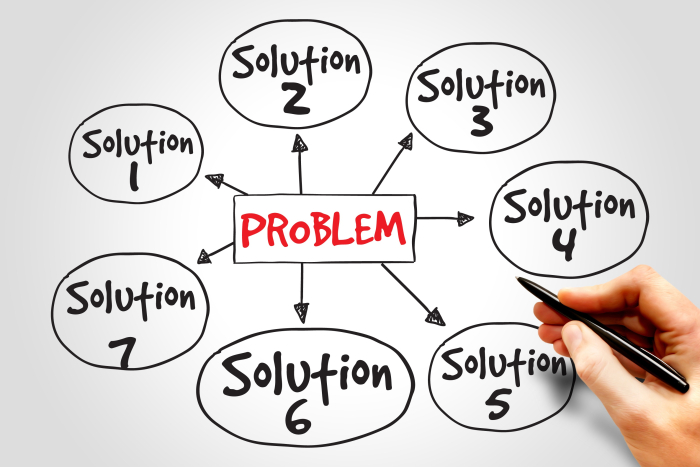
 Data Structure
Data Structure Networking
Networking RDBMS
RDBMS Operating System
Operating System Java
Java MS Excel
MS Excel iOS
iOS HTML
HTML CSS
CSS Android
Android Python
Python C Programming
C Programming C++
C++ C#
C# MongoDB
MongoDB MySQL
MySQL Javascript
Javascript PHP
PHP
- Selected Reading
- UPSC IAS Exams Notes
- Developer's Best Practices
- Questions and Answers
- Effective Resume Writing
- HR Interview Questions
- Computer Glossary
- Who is Who
Problem Solving - Steps, Techniques, & Best Practices
It is essential to know the techniques while solving problems when looking for quality management in a project. Read on to learn more about problem-solving strategies!
Every business organization leads a series of projects at a time to maintain its position in the industry and give tough competition to its contemporary organizations. In the process, it is required to maintain a quality management check for each project. Sometimes, there may be some problems that are necessary to move further with the project.
In other words, problem-solving is important to maintain consistency throughout the project and stand unique. So, here in this article, you will learn about the methods, steps, and best practices of problem-solving.

You scheduled a session with fellow teammates to problem-solve and quickly come up with solutions because your company is experiencing some difficulties. You have been well prepared, have established an agenda, have delivered the problem description, and are currently inviting brainstorming from your coworkers.
Anyone who wants to develop into an expert issue solver must concentrate on the context as well as the content. There are various causes for this, but most have to do with how we think and how we state problems. In this article, we examine the obstacles to, the most successful issue-solving techniques, and the traits of experienced problem solvers.
What is Problem Solving?
The concept involves identifying a situation, figuring out its root cause, locating, ranking, and choosing potential solutions, as well as putting those solutions into action.
No matter how big the problem, it is usually resolved by following a similar procedure: identify the problem at hand, compile prospective answers, select the suitable option, as well as put it into action going forward. That is what is referred to as the problem-solving procedure. Any business issues that are ignored by an organization run the risk of getting worse and leading to failure.
Failure, inconsistency, and problem-solving are mutually exclusive. Any errors in that procedure have the potential to ruin it all.
Steps and Techniques involved in Problem Solving
The fundamental 4 steps involved in problem-solving procedures and methods can be used to resolve issues and discover appropriate alternatives. Management must mentor staff members and cultivate problem-solving capabilities to efficiently lead and operate an organization.
Step 1: Defining or Identifying the Problem
Identify the scenario to keep your attention on the issue and not merely its indications. Utilize cause-and-effect layouts to establish and examine causal factors, and charts and graphs to show the anticipated phases of a procedure while solving problems.
Step 2: Generating the alternative solution
When we concentrate on attempting to achieve the desired outcomes, we skip the chance to acquire new knowledge that could help us become better problem solvers. Choosing the first realistic option, even if it isn't the greatest match, is a frequent issue in problem-solving since possibilities are assessed before they are put out. Well before comprehensive evaluation, the issue must have numerous potential remedies.
Step 3: Evaluating the Alternatives
The best solution is chosen by professional problem solvers using several factors. They take into account the degree to which - A specific solution will address the issue at hand without resulting in any unforeseen issues. It will be accepted by all parties involved and will probably be put into practice. The alternate complies with organizational requirements for evaluation.
Step 4: Implementing and following up on the Chosen Alternative Solution
It is beneficial to acquire help and support from others throughout the implementation process to reduce pushback to later modifications. Leaders may very well be asked to "pitch" the approach, guide others to do so, or assist in its execution with the aid of others.
Step 5: Evaluating the Results
The analysis of the outcomes is the last step throughout the problem-solving methodology. It's critical to keep in mind how the issue affected the business and why it arose in the initial place. Based on what you're attempting to modify or accomplish, it could be accomplished a few days, weeks, months, or a few years after the initial action.
The Best Practices for Problem-Solving
Following are some of the problem-solving best practices you can consider.
Defining Goals to Generate Solutions
Make sure to be as detailed and feasible as you're able to in defining your objectives. Start by defining the ultimate aim, and what it signifies to you, but also the steps you can take to attain it. Try to frame your opinions in terms of steps you can do to accomplish the ultimate result.
Brainstorming
Spend some time coming up with an alternative solution to the issue in the form of brainstorming. Don't hurry with this procedure as we frequently try to avoid issues and find solutions before, they arise. All thoughts, especially those that seem odd or unusual, you must write it. When fixing a certain problem, try to come up with 6-8 different solutions.
Choosing and Selecting the Alternative
Be sure to consider each option. The alternative with the greatest number of benefits and/or the fewest drawbacks may not always be the best choice. Consider what is essential to you and which option will best showcase the advantages that are most important. Next, decide which course of action has the most modest effects. It's crucial to set a timeframe for when you expect to accomplish your main objective.
Executing the Selected Solution
Don't stress over failing. Focus on the path that will take you to the destination throughout this practice and don't stress about potential issues.
Assessment and Evaluation
It's time to assess your accomplishments. Greetings if you were successful! Not to worry if not. Perhaps you didn't quite make the best decision or the circumstance changed. You have undoubtedly gained knowledge.
Conclusion
The best results from problem-solving efforts and strategies come from sticking with a workable approach that is adjusted to focus on potential future developments. There should be communication mechanisms included in the developmental stage, independent of the way the approach is implemented. This makes it possible to continuously check facts against predictions.
It's preferable to clarify the approach to the greatest extent feasible to facilitate the problem-solving technique. It is occasionally essential to restart the procedure from scratch. Try to keep your attention on the remedy as opposed to the issue. Finally, adopt the proper mindset if you want to transform. This includes speaking with the proper attitude and being open-minded and cheerful. Any issue may be resolved with plenty of practice.

